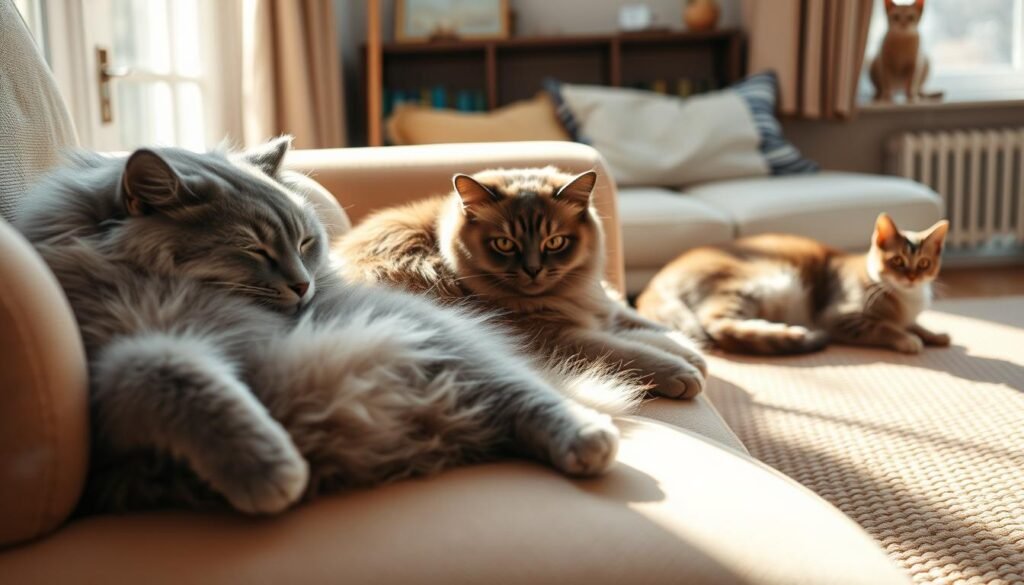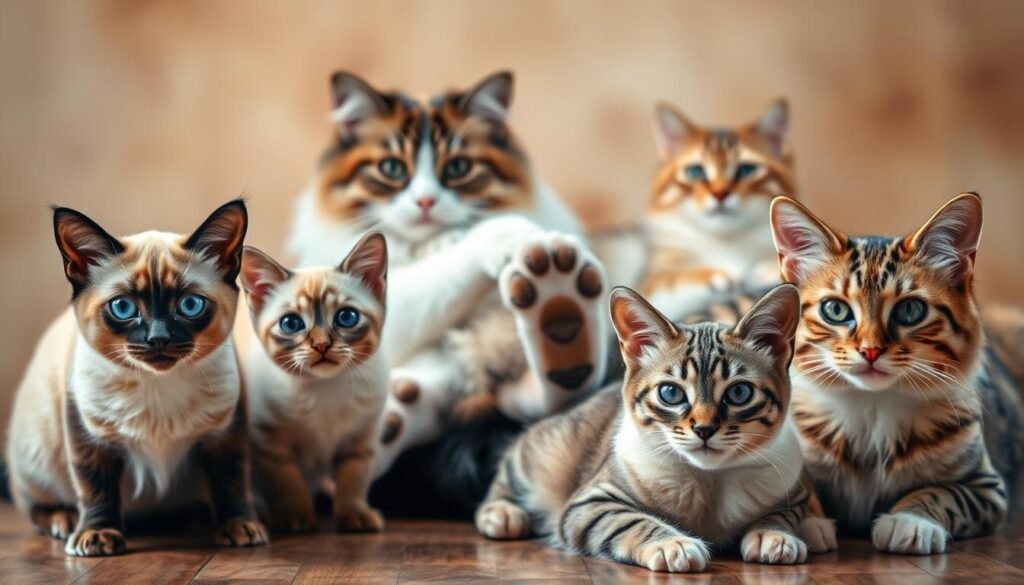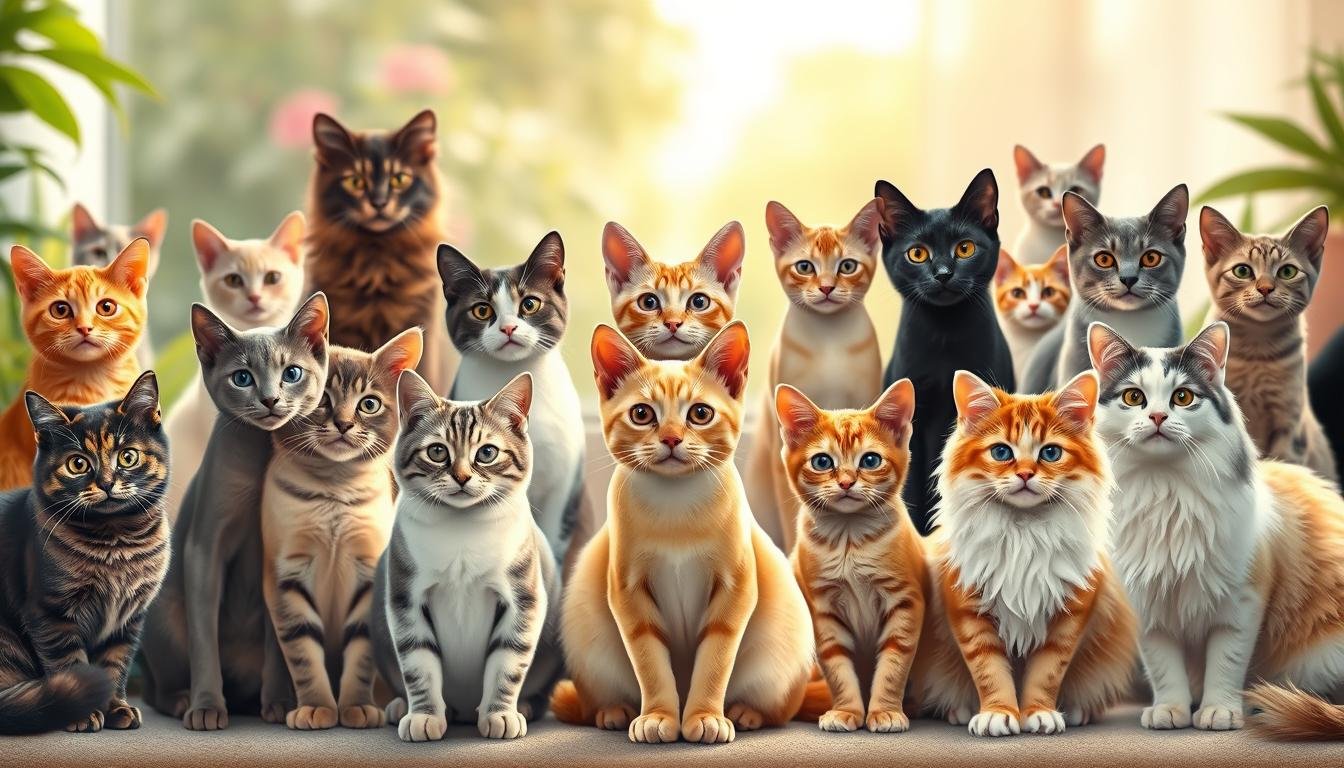Exploring the Top Cat Species Breeds Around the World
If you love cats, you’ve seen how different they can be. From big, fluffy cats to sleek, hairless ones, there’s a lot of variety. This diversity is amazing.
So, what makes each cat breed special? It’s their unique traits and characteristics. These have evolved over time to fit different lifestyles and personalities.
There are so many Cat Species Breeds to discover. Whether you already have a cat or are thinking about getting one, learning about different breeds is fun. It’s a journey that can enrich your life.
Table of Contents
The Fascinating World of Domestic Cat Breeds
Exploring domestic cats reveals a rich history and many breeds. These cats have become a big part of our lives. They fit different lifestyles and tastes.
The Evolution of Domestic Cats Through History
Domestic cats have changed a lot over time. They went from wild hunters to loving pets. Their evolution was influenced by many factors.
How Modern Cat Species Breeds Are Classified and Recognized
Modern cat breeds are sorted based on several things. These include looks, ancestry, and history. Big cat registries help decide this.
Major Cat Registry Organizations
Groups like the International Cat Association (TICA) and the Cat Fanciers’ Association (CFA) are key. They register and promote cat breeds. They set breed standards.
Breed Standards and Classifications
Breed standards describe what a breed should look like. This includes coat, color, body shape, and personality. These standards help sort breeds into groups.
| Registry Organization | Recognized Breeds | Notable Features |
|---|---|---|
| TICA | Over 70 breeds | Recognizes a wide range of breeds, including experimental breeds |
| CFA | Over 40 breeds | Has a long history and is one of the most prestigious cat registries |
Knowing how cat breeds are classified helps when picking a popular cat breed or a favorite cat breed as a pet.
The Best Cat Breeds for First-Time Pet Owners
For those new to cat ownership, some breeds are better than others. You might want a breed that is easy-going, affectionate, and not too demanding. The right breed can make your home a loving place for you and your pet.
American Shorthair: The Classic Family Companion
The American Shorthair has a sturdy build and a short, dense coat. This breed is easy-going and friendly, perfect for families. They also need little grooming.
Ragdoll: The Gentle Giant with a Loving Personality
Ragdolls are known for flopping into your arms, always wanting cuddles. They are among the friendliest cat breeds. They love spending time with their owners and will follow them everywhere.
British Shorthair: Low-Maintenance and Easygoing
The British Shorthair is great for first-time owners. They have a calm and affectionate temperament. Their short coats need little grooming.
Care Requirements and Temperament
All three breeds are easy to care for. They are laid-back and adaptable, perfect for busy homes. But, they still need regular feeding, occasional grooming, and lots of playtime.
Health Considerations for New Owners
Every breed has health concerns to watch out for. Ragdolls might get hypertrophic cardiomyopathy, while British Shorthairs could have hip dysplasia. Regular vet visits are key to keeping your cat healthy.
Choosing one of these breeds will help you create a loving home for your new pet.
Popular Short-Haired Cat Breeds from North America and Europe
If you’re searching for a short-haired cat, look no further than North America and Europe. These places are home to some of the highest-rated cat breeds. They are loved for their looks and unique personalities.
American Shorthair: America’s Beloved Mouser
The American Shorthair is known for its hunting skills and loving nature. It has a broad face and a short, dense coat. This makes it a favorite in America.
British Shorthair: The Teddy Bear of Cats
The British Shorthair is a favorite for its sturdy build and easy-going nature. Their broad faces and short coats make them look like cuddly teddy bears.
Russian Blue: Elegant and Intelligent Companions
Russian Blues are medium-sized cats with a reserved yet affectionate nature. They are smart, love routine, and bond strongly with their family. This makes them perfect for a calm home.
Distinctive Physical Characteristics
The Russian Blue’s thick, plush coat is short, dense, and silvery-blue. Their bright green eyes and gentle face add to their elegance.
Temperament and Social Behavior
Russian Blues are highly intelligent and form strong bonds with their owners. They are quiet and not demanding, fitting well into various homes.
When picking a cat breed, think about temperament, grooming, and lifestyle fit. The breeds mentioned are popular for good reasons. They offer companionship, intelligence, and love that many cherish.
Majestic Long-Haired Cat Breeds Worth Considering
For those who love luxury, majestic long-haired cat breeds are perfect. These cats add elegance to your home and offer love and companionship.
Persian: The Aristocrat of Cat Breeds
The Persian cat is famous for its soft fur and calm nature. It’s a top choice for those who want a relaxed pet. Their big eyes and flat faces make them unique. But, their long fur needs regular grooming to avoid tangles.
Maine Coon: America’s Gentle Giant
The Maine Coon is loved for its size, smarts, and friendly nature. Known as “gentle giants,” they are one of the biggest domestic cats. Their long fur comes in many colors and patterns, making them even more appealing.
Norwegian Forest Cat: The Viking’s Companion
The Norwegian Forest Cat comes from Scandinavia. It’s strong, smart, and loves to play. Their thick fur is water-resistant, and they are great with families.
Grooming Requirements for Long-Haired Breeds
Long-haired cats need regular grooming to keep their fur from matting. This means daily brushing and occasional baths. Without grooming, they might get hairballs or skin problems.
Special Health Considerations
Long-haired breeds are mostly healthy but can face some issues. Persians might have breathing problems, and Maine Coons can get hip dysplasia. Regular vet visits are key.
| Breed | Grooming Needs | Health Considerations |
|---|---|---|
| Persian | High | Respiratory issues |
| Maine Coon | Medium | Hip dysplasia |
| Norwegian Forest Cat | Medium | Generally healthy |
Exotic and Rare Cat Breeds from Around the
For cat lovers seeking something special, exotic and rare cat breeds are a great choice. These cats are not only unique in looks but also have special personalities. They stand out from more common breeds.
Sphynx: The Hairless Wonder from Canada
The Sphynx, known for its sleek, hairless body, came from Canada in the 1960s. They need regular skin care because they don’t have fur. Their loving and playful nature makes them great companions.
Scottish Fold: Unique Ears and Sweet Disposition
The Scottish Fold is known for its folded ears, thanks to a natural mutation. From Scotland, this breed is known for being gentle and loving. They are easy to care for but need lots of interaction.
Origin Stories and Development
The Scottish Fold’s development focused on keeping its unique ears while ensuring health. Their friendly nature has made them a favorite among cat lovers.
Bengal: The Miniature Leopard in Your Living Room
Bengals are energetic cats with patterns that look like wild animals. Their fur shines and they are very playful. Bengals are smart and active, needing lots of play and interaction.
Special Care Requirements
Bengals need lots of exercise and mental play. Regular play and toys are key to their happiness. Their coat is stunning but easy to care for.
Before getting one of these exotic breeds, learn about their needs. Each breed offers a special companionship experience. They are rewarding pets for the right owner.
Whether you like the hairless Sphynx, the Scottish Fold’s unique ears, or the Bengal’s vibrant look, these cats bring joy. Their special traits and loving nature make them top cat breeds for those looking for something unique.
Hypoallergenic Cat Breeds for Allergy-Prone Households
Choosing a hypoallergenic cat breed can make it possible to have a pet without allergies. Many people love having cats, but allergies can make it hard.
Some cat breeds make fewer allergens than others. This is good for homes where allergies are a problem. These cats don’t shed much or make less dander, which causes most cat allergies.
Siberian: The Surprising Low-Allergen Forest Cat
The Siberian cat has a thick double coat, but it’s surprisingly hypoallergenic. Siberian cats produce less Fel d 1, the main allergen that causes human allergies. This makes them a great choice for families with allergies.
Balinese: The Long-Haired Siamese Alternative
The Balinese breed has a medium-length coat that makes fewer allergens. Even though they have long hair, they shed less. This makes them a good option for those with allergies.
Devon Rex and Cornish Rex: The Curly-Coated Options
The Devon Rex and Cornish Rex have unique, curly coats. They shed less and make fewer allergens. This makes them a good choice for homes with allergy sufferers.
Understanding Cat Allergies
Cat allergies come from the Fel d 1 protein in cat dander. While no cat is 100% hypoallergenic, some breeds are better for those with allergies. This is because they produce less Fel d 1 or have low-shedding coats.
Managing Allergies with These Breeds
If you’re thinking about getting a hypoallergenic cat, there are ways to reduce allergies. Regular grooming, vacuuming, and using HEPA filters can help. These steps can lower allergen levels in your home.
| Breed | Allergen Level | Grooming Needs |
|---|---|---|
| Siberian | Low | Regular brushing |
| Balinese | Low to Medium | Regular grooming |
| Devon Rex | Low | Occasional bathing |
| Cornish Rex | Low | Occasional bathing |
By picking one of these hypoallergenic cat breeds and using a few simple steps, you can have a cat. This way, you can enjoy their company while keeping allergies under control.

Selecting from the Best Cat Breeds: Important Factors to Consider
Finding the right cat breed is a big decision. It affects you and your future pet. So, it’s important to think about several key factors.
Matching Your Lifestyle with the Right Breed
Your lifestyle is key in choosing a cat breed. If you’re often away, a low-maintenance breed might be best. For an active person, a lively breed could be perfect.
Space Requirements and Activity Levels
The space you have affects your cat breed choice. Some cats need lots of room to play. Others are happy in smaller spaces. Think about your home and the cat’s needs.
Long-Term Health and Genetic Considerations
Each cat breed has its health issues. Knowing these can help you plan for vet bills. It’s a responsible step in choosing a breed.
Budget Planning for Different Breeds
Some cat breeds cost more to care for. Grooming, food, and health issues can add up. Make a budget to cover these costs.
Multi-Pet Household Compatibility
Adding a new cat to a home with pets needs thought. Some breeds get along better with others. Look for breeds known for being friendly with other pets.
By considering these factors, you can find a cat breed that fits your life. Whether you want the highest-rated cat breeds or the best-rated cat breeds, choosing wisely is crucial. It leads to a happy and healthy bond with your new pet.
Cat Breeds with Extraordinary Personalities and Traits
The world of cat breeds is full of variety. Some cats have unique personalities and traits that catch the eye of cat lovers. These special qualities can make a cat a cherished friend.
Siamese: The Vocal and Social Extrovert
The Siamese breed is one of the oldest and most well-known. It comes from Thailand, now known as Siam. They have striking blue almond-shaped eyes and sleek bodies. Siamese cats are known for being vocal and social, often described as “talkative” because they like to chat with their owners.
Abyssinian: The Playful and Athletic Explorer
Abyssinians are playful and adventurous. They are very energetic and love to explore. This makes them a great fit for homes that are always on the move.
Japanese Bobtail: The Lucky Cat with a Distinctive Tail
The Japanese Bobtail is known for its short tail. In Japanese culture, they are seen as lucky. They are friendly and outgoing, making them a joy to be around.
Intelligence and Trainability
Many of these breeds are not just charming but also very smart. For example, Siamese and Abyssinian cats can learn tricks and interact with their environment in clever ways.
Social Needs and Family Compatibility
Choosing a cat breed means thinking about your lifestyle. Breeds like the Siamese and Japanese Bobtail are very social. They need lots of interaction, making them perfect for families or people who are home a lot.
Here’s a comparison of these breeds based on key characteristics:
| Breed | Intelligence | Social Needs | Family Compatibility |
|---|---|---|---|
| Siamese | High | Very Social | Excellent |
| Abyssinian | High | Social | Good |
| Japanese Bobtail | Moderate to High | Very Social | Excellent |

Conclusion: Finding Your Perfect Feline Match
Exploring cat breeds shows each one has its own special mix of love, play, and friendship. Whether you like the long-haired or short-haired cats, there’s a perfect one for every home.
Think about your lifestyle, how much space you have, and the cat’s health when choosing. This way, you can pick a cat that will make your life happier and more fulfilling.
This article has shown the amazing variety of cats out there. Knowing about these differences helps you choose the right cat for you and your lifestyle.

